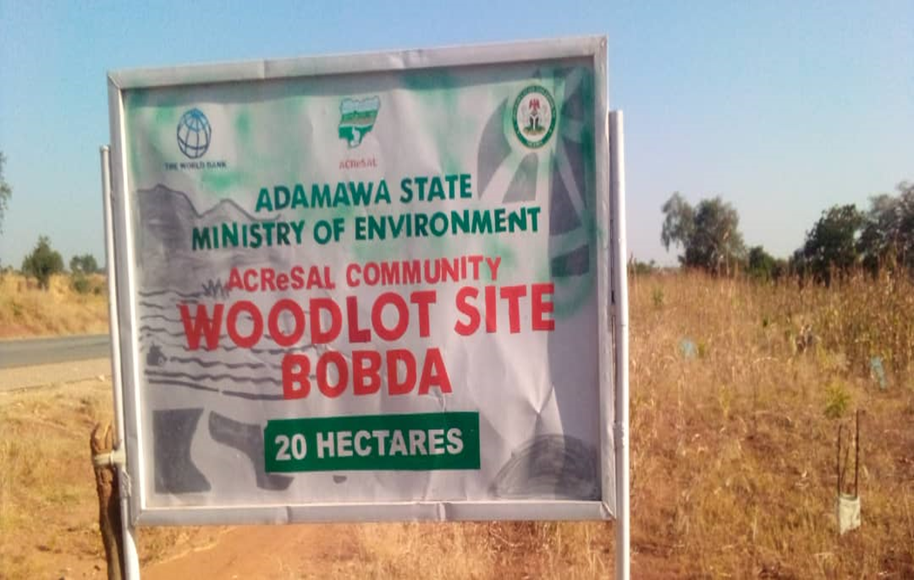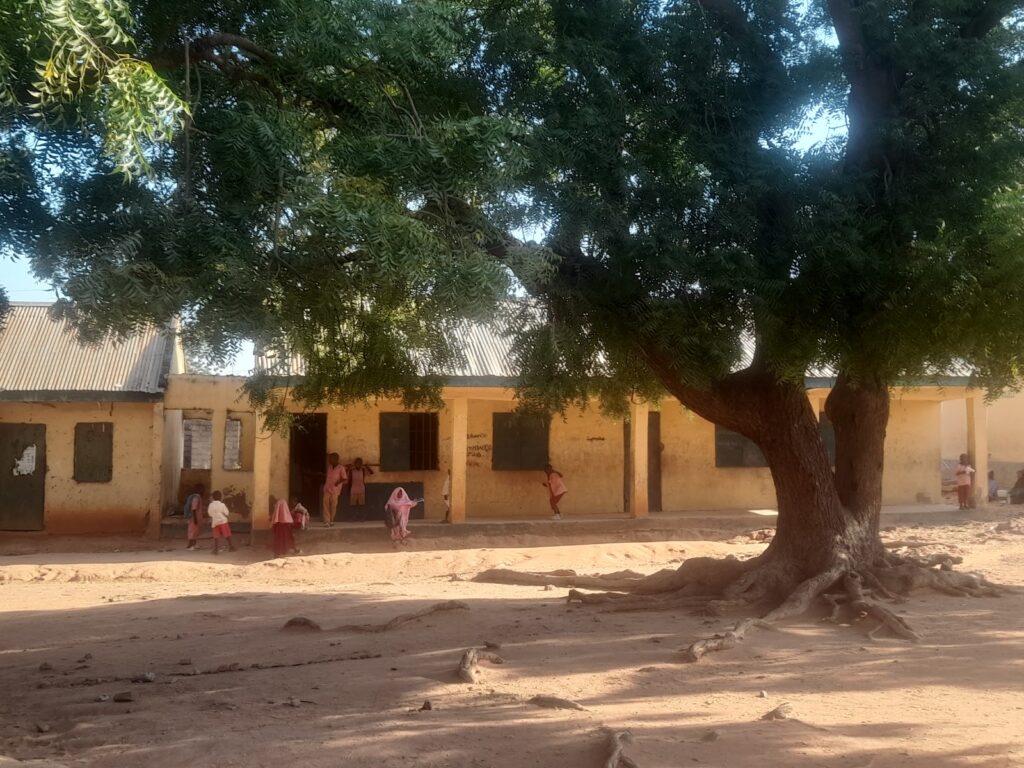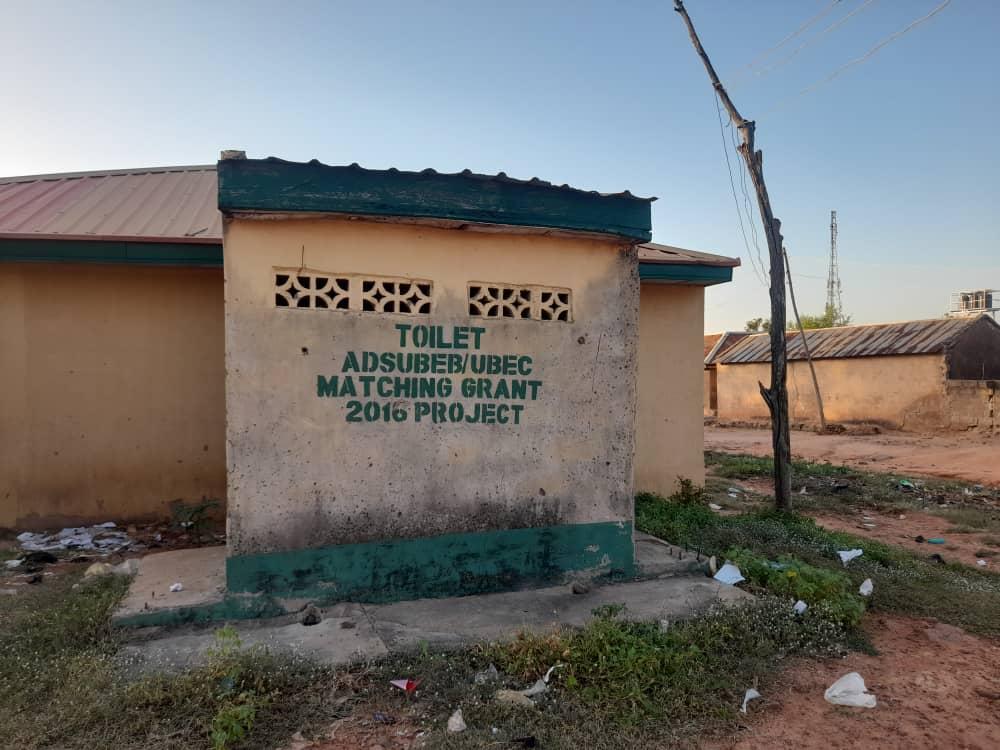As the warm morning sun cast its golden rays over the serene landscape of Bobda, a small village in the Jada Local Government Area of Adamawa State, northeastern Nigeria, 12-year-old Halima Bawuro, sat quietly, observing her father, Sa’ad Bawuro, who was diligently taking care of the trees planted by an organisation.
Asked why she wasn’t in school with her peers, she told HumAngle that her father deems the three-kilometre journey from her house to school too far to undertake daily.
Halima’s story is a haunting reflection of the harsh reality of many girls residing in the remote areas of Adamawa. Many times, they are forced to make impossible choices between their safety, well-being, and education.

Despite Governor Ahmadu Fintiri’s efforts in promoting gender representation in the state, with notable appointments including a female deputy governor, a female chief judge, and 21 female local government vice chairpersons, young girls are still faced with challenges of pursuing quality education due to limited school infrastructure.
“We have to prioritise the safety of young girls. So, they are often advised to stay back at home to help with domestic chores,” said Sa’ad Bawuro.
Failed strategy?
In August 2022, the Adamawa government formulated a Medium-Term Sector Strategy (MTSS) to guide education policies within the state from 2023 to 2025. The ministry responsible for carrying out the plans outlined in the MTSS is the Ministry for Education and Human Capital Development.
It was developed to address some systemic challenges, including gender disparities hindering girls’ access to quality education in Adamawa communities. The targets include an increase in enrollment rate from 86 per cent to 95 per cent at all levels of schooling by 2025; to ensure that 100 per cent of the state’s children are attending basic school by 2025; renovation of the dilapidated school infrastructure, employment of more qualified teachers in critical areas of need; provision of sporting facilities and WASH facilities in schools.
Other targets are the provision of school pupils’ access to relevant textbooks and an increase in adult literacy and numeracy rates to over 75 per cent. However, recent findings show that Adamawa has yet to create a more inclusive learning environment for girls, thereby leaving a huge gap in the education system.
In fact, some teachers said they aren’t aware of MTSS.
Musa Joe, a staff of Government Day Junior Secondary School, Lainde in Yola, said he only heard about MTSS at a workshop a few months ago, underscoring the disconnect between policymakers and educators.

“I have never been invited, and I am also sure that the principal of this school has never been invited to provide his insights regarding the development of such a plan,” he said with a tone laced with a sense of exclusion.
Child marriage
As some of these young girls struggle to be in school, early marriage casts a long shadow over their lives, stifling their educational aspirations and crippling their career prospects. A 2021 report by Save the Children International reveals that a whopping 78 per cent of girls surveyed in Northern Nigeria were married off before their 18th birthday. The statistics are equally concerning in Adamawa where 10.7 per cent of girls surveyed were married before 15 and 36.4 per cent before 18, according to the 2021 Multi-Indicator Cluster Survey (MICS) survey developed by UNICEF.
Speaking with HumAngle, Khadijat Abdullahi’s voice trembles as she narrates the heart-wrenching story of her best friend’s abrupt departure from school after she was married off last year. With her eyes clouding with worry, she said, “I’m afraid the same fate might await me.”
The 15-year-old Junior Secondary School student at the Government Day Junior Secondary School wished someone could enlighten her parents that education is as important to girls as it is to their boys. Khadijat’s fears point to the glaring gaps the MTSS plan has overlooked, which is community outreach and awareness programmes that tackle the deep-seated socio-cultural barriers to girls’ education.
For girls like Khadijat, caught between personal aspirations and family expectations, the absence of supportive policies means an inevitable compromise of their educational and personal growth.
More concerns about MTSS
While there have been reported cases of gender-based violence (GBV) within schools, the MTSS plan lacks provisions for addressing GBV or promoting gender-sensitive school environments for girls like Maryam Hashimu, a 14-year-old student at Capital Secondary School in Yola, who shared her harrowing experience within the supposedly safe walls of her school.
“Boys in my school often taunt and harass me and my friends,” Maryam explained. “They follow us home, making us feel scared. When I reported these incidents to some teachers, I was shocked by their response. Instead of offering support and protection, they scolded me, saying I play with them a lot, and that’s why such happens,” she narrated amid disappointment.
One teacher’s response still resonates with Maryam after she was accused of dating the boys, and that’s why they were harassing her. “I wish someone would take action to ensure our safety and well-being in school,” she added.
Lack of WASH facilities in schools
Though one of the targets of MTSS education policies from 2023 to 2025 is to ensure the provision of water, sanitation, and hygiene services in schools, girls in secondary schools are still affected by critical health-related issues. According to UNICEF, lack of appropriate facilities such as gender-segregated improved toilet facilities, adequate safe water supply in schools for washing hands and soiled clothes, facility for drying of clothes, and absence of sanitary menstrual materials can prevent girls from safe, hygienic management of their menstruation which can lead to various diseases.
Additionally, the Water Sanitation and Hygiene National Outcome Routine Map of 2021 by UNICEF says only eight per cent of Nigerian schools have girls’ toilet compartments with provisions for menstrual hygiene management. Hence, many girls are forced to miss school during their menstrual cycles, leading to a decline in academic performance.
Catherine Kiliobas, a 14-year-old JSS3 student of Government Day Secondary School, is one of many girls whose parents cannot afford to buy sanitary products regularly, and the school doesn’t provide them either. So, she often relies on donations from non-governmental organisations. Coupled with the poor state of the toilet facilities in her school, she usually skips school during her menstrual period.
“To make matters worse, the school’s water supply often runs dry, rendering the toilets unusable for students,” Catherine said.

‘Why gender-responsive planning is important’
According to the Global Partnership for Education (GPE), the world’s only partnership and fund focused on providing quality education to children in lower-income countries, gender-responsive education sector planning (GRESP) is crucial for an equitable and effective education system, and it’s the vehicle for identifying gender barriers within the education system.
“Education transforms lives. It is the surest investment to break down social and economic differences between people, unravel inequalities based on gender and accelerate progress towards the entire vision of the 2030 Agenda for Sustainable Development. Yet, despite the world’s commitment to ensure every child completes 12 years of quality education, in low-income countries only 4 per cent of the poorest finish upper secondary school, falling to 2 per cent amongst marginalised girls,” GPE said in a 7-page policy document obtained by HumAngle.
“Implementing gender-responsive education sector planning means that: differences in interests, needs, priorities, opportunities and outcomes between girls, boys, women and men are analysed and used to inform development of the sector plan, context-specific gender issues are taken into consideration at every level in the analysis, planning and budgeting cycle, actors from gender and other sectors participate in stakeholder consultations, representing civil society organisations (CSOs) and local communities as well as government departments, and adequate financial resources are allocated to gender equality and girls’ education strategies,” the group added.
Authorities
Meanwhile, efforts by HumAngle to get the reaction of Adamawa State’s Commissioner for Education, Umar Garba Pella, proved abortive as he did not respond to calls seeking his comments. Even though a meeting was scheduled through his aide for Oct. 17, Pella was said to have other ‘important’ engagements.
However, a Director with the Adamawa State Universal Basic Education Board (ADSUBEB), Enoch Nadabo, said in some remote areas of Adamawa, where early marriage often takes precedence over formal education, a well-crafted gender-responsive education sector plan would be a game-changer.
“When girls are encouraged and supported by their communities to attend school, rather than being forced into early marriages, dropout rates will decline, and their social growth will become evident,” Nadabo added.
On his part, Markus Joel, the Vice Principal of Government Day Junior Secondary School, Lainde in Yola, said improving school facilities to include private, clean, and well-equipped toilets and providing menstrual hygiene products will ensure that girls stay longer in school, which will ultimately benefit their academic outcomes.
This report was developed with collaborative support from ImpactHouse Center for Development Communication and System Strategy and Policy Lab (SSPL).
